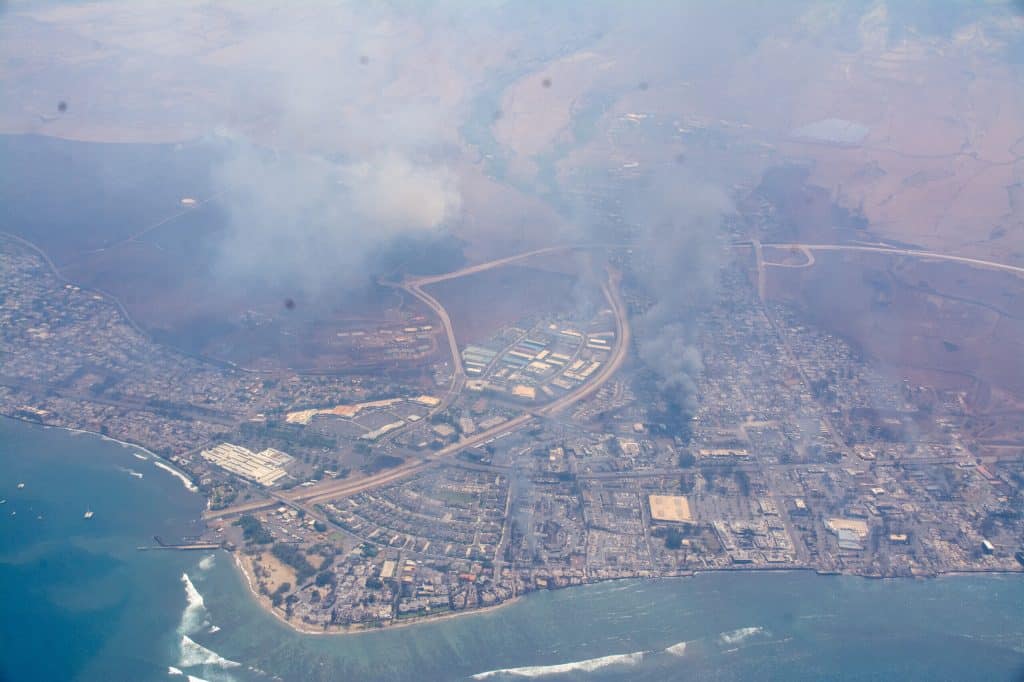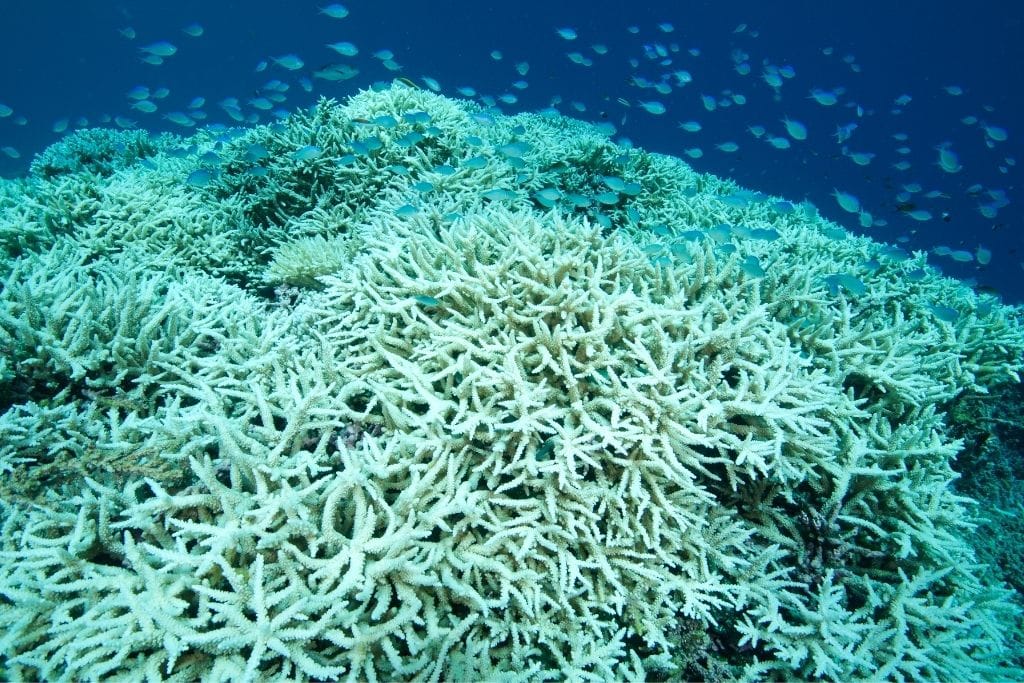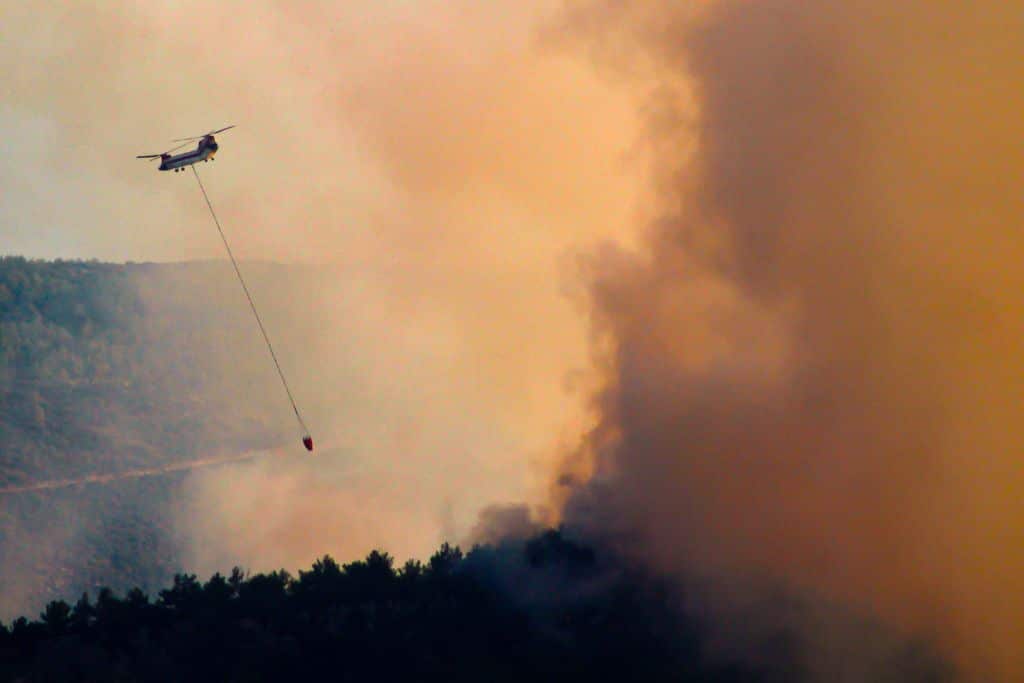As we bid farewell to 2023, a quick look back reveals a year marked by severe droughts, scorching wildfires, rising ocean temperatures, impactful summits, and critical environmental policies. These events echo the pressing need for swift and collective action in the face of our changing climate.
—
Wrapping up 2023, it is worth revisiting the key climate events that defined the year – those moments that truly left an impact on our planet. Earth.Org looks back at some of the major occurrences and events that took place in the past twelve months.
2023 Natural Disasters
Droughts
This spring, Europe faced a severe water crisis intensified by a multiyear drought due to low winter rainfall and snowfall. Though there was some relief in Southern Europe as the precipitation pattern shifted to normal or above-average wet conditions between April and June, the overall outlook remained critical.
Persistent scarcity and heatwaves adversely affected crops, with the Baltic Sea, Scandinavia, the UK, Ireland, Spain, and Germany grappling with a severe meteorological drought that has compromised crop yields in some regions.
In Spain, for example, some regions were forced to impose restrictions on water use for agriculture and industries as well as for the irrigation of public gardens and swimming pool refilling amid the driest April in the country’s history. Extreme temperatures also led to a surge of olive oil prices of about 60% since last June. Last year’s record-breaking European heatwaves – which the European Drought Observatory described as the worst in at least 500 years – had already compromised olive crops across the continent. Spain, Europe’s largest producer, was among the hardest-hit countries and saw annual supplies drop by half to about 780,000 tonnes in the past 12 months.
Widespread fire danger persisted, especially in the Iberian Peninsula and the Maghreb region, owing to exceptionally dry conditions, while Italy endured the second consecutive year of snow shortage, one of the worst in the last 30 years.
You might also like: Europe’s Warmest Winter on Record Forces Closure of Ski Slopes
Reduced water levels in the Rhine, one of Europe’s major rivers, caused concerns for shipping and navigation across Germany. The UK also experienced record-low river levels, raising the risk of severe water shortages. The British Met Office noted a 30% chance of drier-than-average conditions, highlighting the importance of proactive preparation. Experts emphasized the need to adapt to prolonged droughts, pointing out the role of climate change in exacerbating the situation.
On the other side of the world, severe drought affected 5% of the contiguous states in the United States. In China, 15-20% of the population saw a rising frequency of moderate-to-severe droughts, the intensity of which is projected to surge by 80% by 2100.
In September, Brazil’s Amazon River saw an unprecedented water shortage, with water levels approximately six meters below the previous year. Communities in the area faced resource shortages due to record-high temperatures and unusual dryness in the river’s basin. The abrupt death of 120 Amazonian river dolphins has also raised concerns about biodiversity loss.
The year’s global drought summary was highlighted in the COP28 Global Drought Snapshot 2023, which emphasizes the pervasive and silent impact of drought on ecosystems, economies, and human lives, underscoring the urgent need for global drought resilience through proactive measures, sustainable practices, and international cooperation.
Heatwaves and Wildfires
Summer 2023 saw a worldwide wildfire crisis exacerbated by record-breaking temperatures, dry conditions, and human-induced factors such as inadequate fire emergency systems. From Canada and Mexico to Greece and Hawaii, wildfires pushed communities to the brink of economic and environmental collapse.
This tragedy unfolded on an unprecedented scale, highlighting the profound impact of climate change, aptly termed “global boiling” by UN Chief António Guterres. The crisis underscored the fragile connection between human activities and the surge in wildfires, with rising temperatures accelerating water evaporation and creating prime conditions for devastating infernos.
The wildfire crisis in Greece exposed a harsh reality: human actions significantly contribute to exacerbating environmental catastrophes. Shockingly, human hands, whether through negligence or intent, were identified as the primary ignition sources. The disturbing emergence of patterns suggesting deliberate arson raises concerns about a troubling trend. The grim synergy of human behavior and changing climate conditions, exemplified by rising temperatures and prolonged heatwaves, created a dangerous environment where even minor sparks could lead to devastating infernos.
The wind-whipped August wildfires in Maui, Hawaii, emerged as one of the deadliest in modern US history, claiming at least 115 lives and marking a historic crisis for the island. Devastating wildfires were fueled by a combination of potent factors, including strong winds and extremely dry conditions. The Maui fires became a stark reminder of the urgent need to address fuel problems, implement proactive fire management strategies, and acknowledge the socio-economic repercussions of the climate crisis.
The crisis underscored the complex relationship between climate change, human actions, and the imperative for collaborative efforts to mitigate the escalating risks of wildfires on a global scale.

You might also like: Summer 2023 Was the Hottest on Record Globally By a Large Margin, Scientists Say
Elevated Ocean Surface Temperatures
In the wake of the destructive wildfires from June to August 2023, another concerning development unfolded: a notable rise in the average ocean temperature. The primary catalyst behind this calamity is the El Niño weather phenomenon. Starting in April, the ocean’s temperature was on a steady ascent that culminated in an astounding 20.9C in July.
The reality stood stark: in just one month, global sea surface temperatures surged a staggering 0.51C above the 1991-2020 average, providing an undeniable signal of our evolving world. This extraordinary event also featured fluctuations in the North Atlantic marine heatwaves.
A study conducted by the School of Biological Sciences at the University of Adelaide has exposed a sobering truth: over 70% of the world’s most biodiverse regions are now under threat due to rising temperatures in the waters they call home. This vulnerability stems from the fact that a significant portion of marine life, including vital species like plankton and fish, inhabit the surface layers where temperature fluctuations are most pronounced. Shockingly, a mere fraction of a degree rise in water temperature can set off a domino effect of far-reaching consequences, such as ocean deoxygenation, natural marine habitat losses, shifts in commercial fish distribution, and disruptions in marine animal migration patterns.
The global significance of aquatic ecosystems gained prominence with a historic milestone achieved after more than 15 years of negotiations among United Nations (UN) member states. The UN’s adoption of a High Seas Treaty in June 2023 marks a resounding victory for the protection of the high seas, the vast maritime expanses that extend beyond individual nations’ exclusive economic zones.
You might also like: Record Ocean Temperatures Push World Climate and Marine Life Into Risk Zone, EU-Backed Study Shows
Storms
In September, the world witnessed a series of devastating extreme hurricanes, underscoring the intensifying impact of the global climate crisis. Libya faced a humanitarian catastrophe as Storm Daniel triggered floods claiming over 11,000 lives, revealing the vulnerabilities of a nation grappling with a prolonged civil war and inadequate infrastructure.
Simultaneously, the Mediterranean region and parts of Asia experienced deadly storms and typhoons, while the Americas confronted unprecedented disasters, including Brazil’s extreme floods and the stranding of Burning Man attendees in the US desert.
You might also like: Another Year For the Record Books: A Recap of the Main Extreme Weather Events in Summer 2023

2023 Global Climate Agenda
This year stands out not just for its weather events but also for noteworthy climate initiatives and reports, reaching a pinnacle with the culmination of the COP28 Global Stocktake.
European Union’s 2023 Clean Energy Report
In the landscape of global energy transition, the European Union has taken significant strides in reshaping its clean energy policy, as highlighted in the Clean Energy Technologies Competitiveness Progress Report. Released as part of the State of the Energy Union Report, the document meticulously evaluates the EU’s competitiveness in various clean energy sectors, addressing challenges such as raw material costs, supply chain issues, and skills gaps.
Amidst global economic uncertainties, the report not only underscores the resilience of the EU’s clean energy technologies but also showcases a steadfast commitment to sustainability and stability in the face of adversity. The human aspect of the clean energy sector is explored, emphasizing positive employment trends but also recognizing the need to bridge the skills gap. While excelling in clean energy research, the report calls for a shift towards real-world impact, emphasizing the symbiotic relationship between regulatory policies and financial support.
With a specific focus on technologies like solar PV, wind turbines, ocean energy, and batteries, the EU’s approach involves addressing distinct challenges in each segment. As the 27-nation bloc aims for climate neutrality by 2050, the report outlines a plan for carbon dioxide (CO2) capture, underlining the importance of ongoing research, public funding, and strategic cooperation to overcome barriers and lead the global transition towards clean energy.
The Lancet Countdown Report
The Lancet Countdown is a yearly wake-up call, reminding us that climate change is not just about polar bears – it is a major threat to our health. Born from the Paris Agreement in 2015, it scrutinizes how well governments are keeping their promises to limit global warming. Tracking 47 indicators, the report covers everything from climate impacts to our efforts in adaptation and mitigation. What stands out is the global collaboration supporting it, which engages 114 experts from various fields.
The 2023 Lancet Countdown report focuses primarily on the urgent need for a health-centered approach to address the irreversible consequences of climate change. Released just before COP28, which uniquely prioritizes health, it calls for commitments and actions for an accelerated, equitable transition. Without rapid mitigation addressing climate change’s root causes and supporting adaptation, human health faces significant jeopardy.

UN’s Climate Ambition Summit
In the Chair’s Summary of the Climate Ambition Summit 2023, convened in New York in September, leaders from government, business, finance, local authorities, and civil society united as “first mover and doer” to showcase substantial actions in global decarbonization and climate justice. Key outcomes featured a shared recognition of the pressing climate crisis, pledges for ambitious emission reductions, and the presentation of detailed transition plans.
The summit underscored the necessity for policy certainty, tailored financial instruments, and international collaboration to confront climate impacts. Addressing accountability, adaptation finance, and decarbonization challenges, the sessions emphasized a cooperative, science-backed approach to a sustainable and equitable future.
G20’s New Delhi Summit
The G20 New Delhi Summit of 2023, a confluence of political, economic, and socio-cultural considerations, spotlighted the critical realm of environmental politics. The G20 Leaders’ Declaration, officially ratified on September 9, 2023, addressed a range of pressing environmental challenges. These included sustainable development goals, a firm commitment to climate finance, the imperative of decarbonization, transitioning to cleaner and more sustainable energy sources, preserving and nurturing ecosystems, promoting a resilient ocean-based economy, battling against plastic pollution, strategically focusing on disaster risk reduction, and fortifying infrastructure resilience.
The New Delhi Summit accepted the commitment to “pursue and encourage efforts to triple global renewable energy capacity by 2030”, but failed to agree on the fossil fuel phase. This imperative for action was emphasized by the challenges encountered in the preceding G20 Energy Ministers’ meeting earlier this year.
The agreement positioned climate change, biodiversity preservation, and the reduction of disaster risk at the forefront of global priorities, recognizing the far-reaching economic implications entailed by these environmental imperatives and incorporating principles such as common but differentiated responsibilities – a concerted effort to strike an equilibrium of responsibility among nations in addressing the exigencies of our shared global environment.
COP28: The Global Stocktake
COP28 in Dubai, spanning two weeks, placed a spotlight on the inaugural Global Stocktake (GST), overshadowing other environmental agendas. Against the backdrop of climate-related disasters in 2023, including widespread wildfires and flooding, COP28 signifies a pivotal moment between the signing of the Paris Agreement in 2015 and the 2030 target year.
Acknowledging the scientific evidence indicating the need for a 43% reduction in global greenhouse gas (GHG) emissions by 2030 compared to 2019 levels to limit global warming to 1.5C, the stocktake highlights that Parties are currently falling short of their goals outlined in the Paris Accord and urges them to take concerted action on a global scale to triple renewable energy capacity and double energy efficiency improvements by 2030.

In terms of much needed action on global warming adaptation, the final COP28 deal, agreed upon on December 13 after two weeks of intense negotiations, requires countries to deliver a national adaptation plan by 2030 – 51 countries have already done so. As for the Adaptation Fund, a few developed countries have pledged a total of 160 million, half of what is needed to move forward on the Global Goal on Adaptation (GGA). The Fund was established in 2001 “to finance concrete adaptation projects and programmes in developing country Parties to the Kyoto Protocol that are particularly vulnerable to the adverse effects of climate change.” Contributions to the Fund announced in Dubai by some European countries, including the UK, Italy, and France, are notably low.
Featured image: Utku Kuran
You might also like: Did COP28 Succeed or Fail?


















